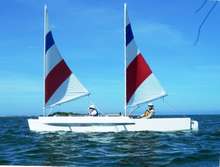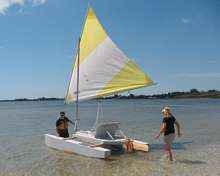Or, How A Slow Kayak Got Me Building Fast Sailboats by "The DIY-Tri Guy"
Part One - Part Two
Continued from yesterday...
The result of my first “real” effort to design and build a trimaran from scratch was extremely positive – especially for a novice sailor like me. It was so smooth and stable underway, and left such an absolutely trivial wake, that I named it No Commotion. With just a single, unstayed 85 sq. ft. leg-o-mutton sail, this 16-foot single-seater hit 12 mph (and later hit 14 mph with a bigger rig).
Of course, the very first time my wife sailed No Commotion, she said she wanted a small tri of her own! Bummer – now I have to build another boat… Well of course, that really was just fine with me, since I’d already become a boat-building junkie. But No Commotion was a V-hull, so I figured I’d try something different for Laura’s Boat.
What should be different? Well, the 16’ length was fine. But the beaches here can be VERY shallow at low tide, so shoal draft was a big priority. But I also wanted to be able to take off - upwind - in just 6” of water. And I definitely didn’t want square chines, which are really noisy and cause lots of drag at any speed. And I had already come to love leeboards, so they were also mandatory. The logical solution? A flat bottom panel, minimal rocker, two smallish bilge panels, and vertical side panels. Thus was born Laura’s Boat, which soon became my favorite boat to sail.
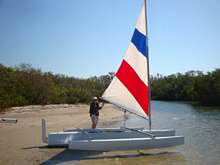 |
And for reasons I’m still not quite sure of, it was better in just about every way than No Commotion. Laura’s Boat turned more easily, tacked more quickly, and was faster in light air while being at least as fast in a stiff breeze. It could be launched in shallower water, had better shoal clearance, and sat flat on its bottom on the beach - no small benefit when you have to assemble and disassemble it every time you sail, which you can see us both doing here….
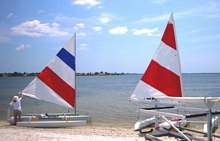 |
There were only two things that No Commotion did better than Laura’s Boat. Its sharp V-entry make it a bit quieter heading into a chop, and the V-hull tracked a slight bit better. But since Laura’s Boat was the one I much preferred to sail, its 5-panel hull design became the blueprint for most of my future hulls. In fact, the 19-footer you see below is a faithful copy of the Laura’s Boat hull, simply increased by 15% in every dimension. This gave me a boat that could easily accommodate two people, while a sliding “seat + foot pedals” arrangement and twin leeboards allowed me to keep the helm perfectly balanced under all conditions.
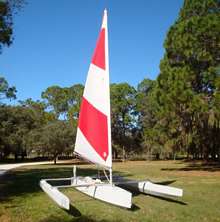 |
Now, I knew that increasing all of Laura’s boat’s dimensions by 15% would produce a boat that was a lot more than 15% heavier. But I was a bit shocked to discover that the (still unnamed) 19-footer was a full 50% heavier than Laura’s Boat. I had also increased the length of the amas from 12’ (on my 16’ boats) up to 18’, and increased the max beam from 12’ to 14’6”.
On the one hand, all these increased dimensions made for a boat that was a lot harder to get off and on the trailer than Laura’s Boat. It also took up more beachfront real estate - something that can be in short supply at high tide. And the greatly increased windage made it very tricky to maneuver onto the trailer in a crosswind.
But once on the water, the 19-footer was an absolute dream to sail. It felt much, much sturdier and more stable than the 16-footers, and sailed comfortably in seas that would have found the smaller boats still on their trailers. And with the 128-sq. ft. sail I eventually had made for the 19-footer, it was even quicker in light air than Laura’s Boat.
And then there was the nimbleness - something I hadn’t expected in a boat this big. It tacked beautifully and never, ever got stuck in irons. I think the twin leeboards and the big low-aspect rudder also played a role in the nimble handling, which came as a very pleasant surprise. And when I finally added an outboard motor mount, the 19-footer quickly became my first choice for a day sail.
Then there’s the 24-footer. Why did I build a trimaran 24’ long? Because I’m cheap! See, I had two identical sails of 85 sq. ft. each that had an 11’ long foot, and I wanted to use them both on one boat. I didn’t know that it would be a “cat-ketch,” but I figured that 170 sq. ft. of sail would move it right along, especially if the max beam of the main hull was just 23”. That’s a long, skinny boat!
In a radical departure from my usual ply-panel construction, I decided to make the entire bottom section of this boat out of foam - 8” of it, to be exact. Basically, the hull was made up from three simple sections - two side panels 16” high and a flat-bottom panel 23” wide. Then I started gluing on the 2”-thick sections of foam, and then shaping the whole mess so it looked like a boat. And you can get wonderful curvy shapes from sculpted foam that you could never get close to with flat plywood panels.
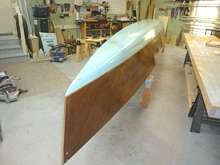 |
So how did it sail? I was using recycled 12’-long amas from another boat, which were a bit short but had high flotation and a planning bow shape. The boat also had max overall beam of 18’. This made it incredibly stable no matter how much sail we put on it. And when I one day loaded it up with almost 200 sq. ft. of sail, the performance just amazed me. With my customary twin leeboards deployed, we were holding a steady 9 mph just 45 degrees off the wind, which was averaging about 12 mph. And they say cat-ketches don’t do well upwind!
But not all of my boats made me quite this happy. Here are a few of my not-so-noble efforts….
Failures aside, though, all of this experimentation has led me to one conclusion: Small trimarans are simply the most fun boats to sail - especially if you like to sail for just a few hours at a time like I do. And as I discovered the joys of sailing these delightfully quick and nimble little tris, my kayaking dropped off dramatically. In fact, when I take a kayak out these days, I keep wishing I had a sail rig along for the ride. (Here’s a sail rig that was really zippy…)
Note About Plans: Over the years I’ve gotten quite a few requests for plans, and most of them were for “Laura’s Boat.” If you have any interest in owning one of these great little tris, I’ve made several improvements to the original design to create “Laura’s Boat II.” An extremely thorough set of plans will soon be available, and they will be offered right here at Duckworks!
|





